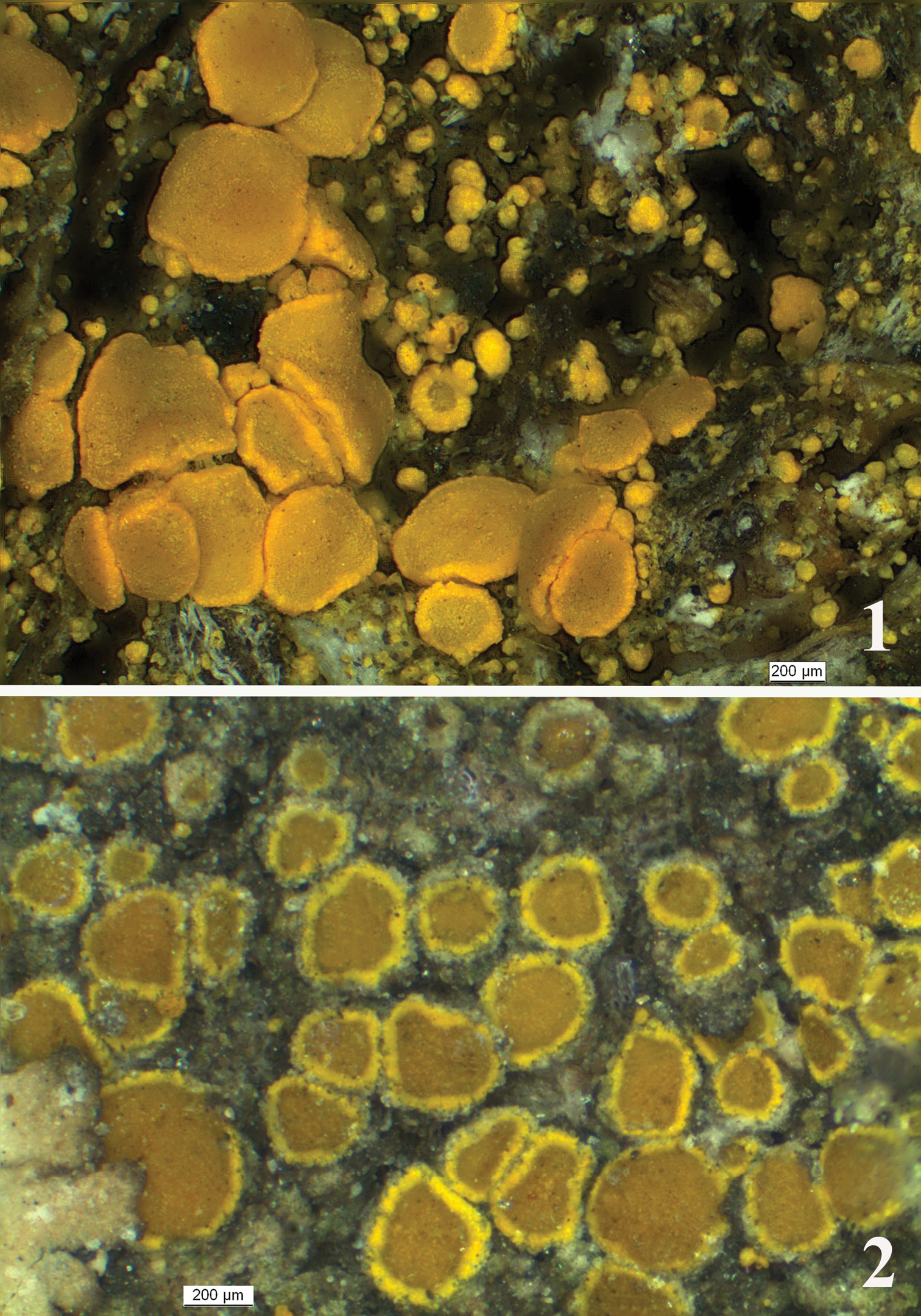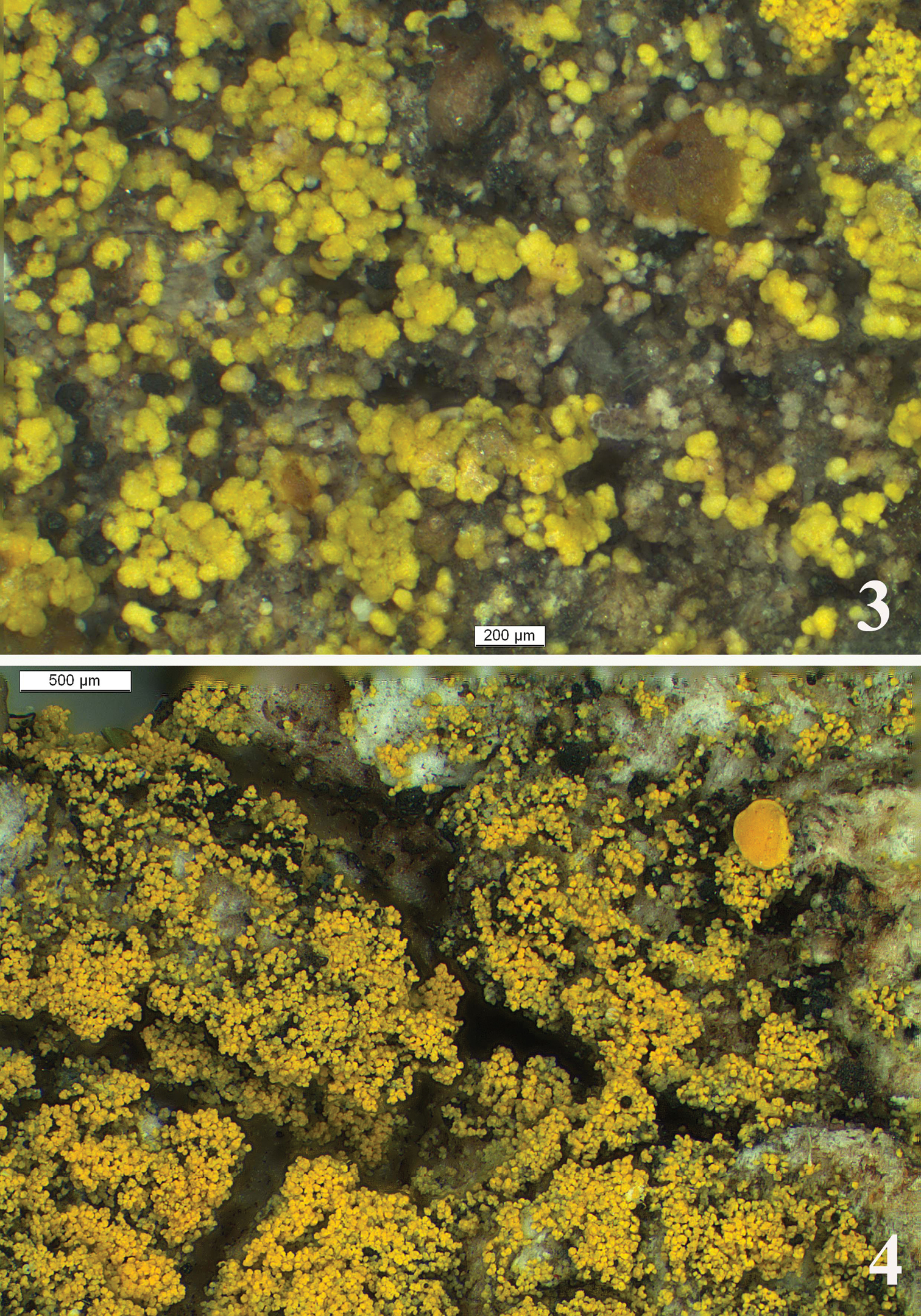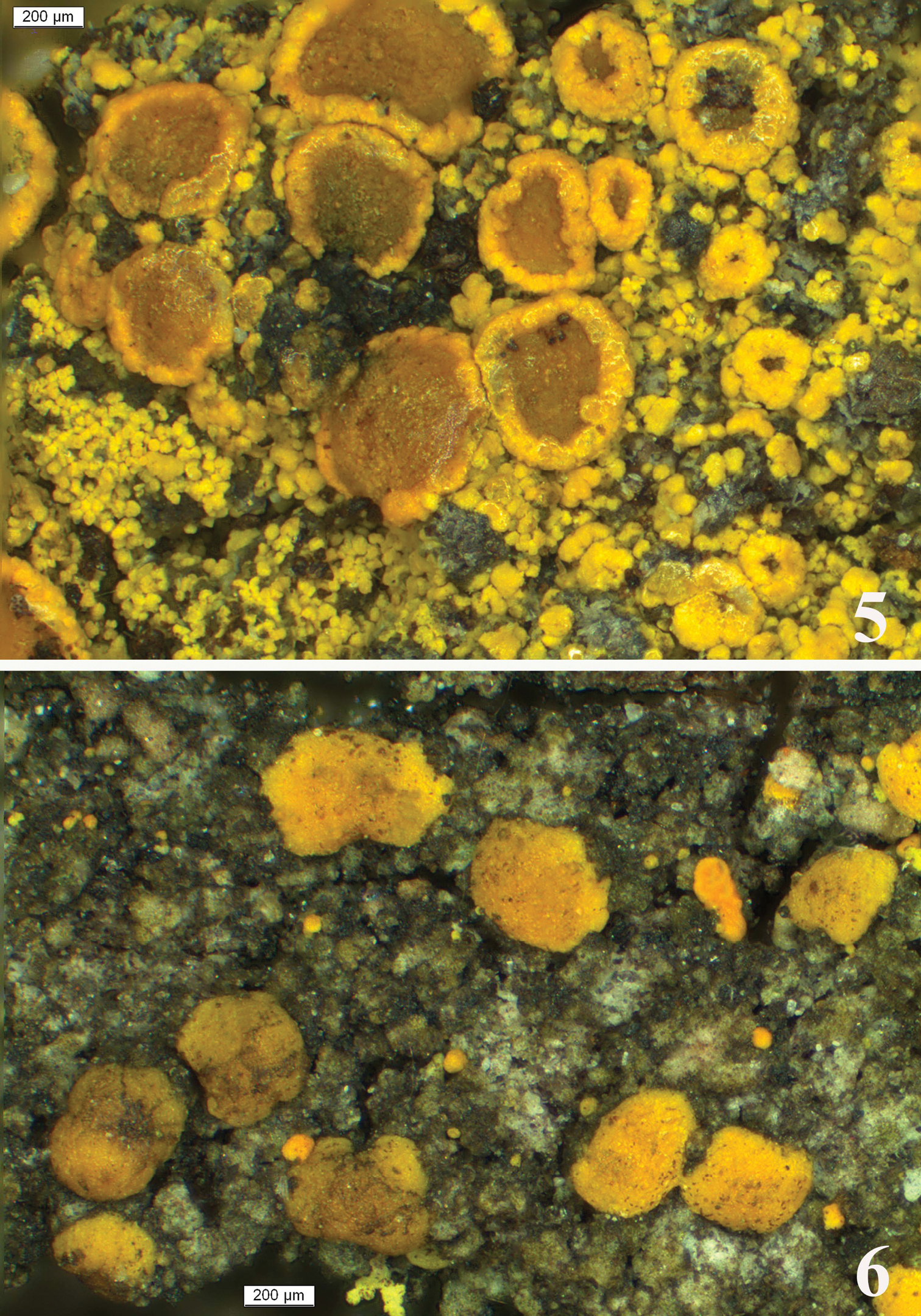






(C) 2012 Martin Westberg. This is an open access article distributed under the terms of the Creative Commons Attribution License 3.0 (CC-BY), which permits unrestricted use, distribution, and reproduction in any medium, provided the original author and source are credited.
For reference, use of the paginated PDF or printed version of this article is recommended.
Candelaria pacifica, Candelariella antennaria, Candelariella boleana, Candelariella granuliformis and Candelariella xanthostigmoides are reported from Switzerland for the first time. Candelariella xanthostigmoides is also new to Europe. Candelariella aggregata, Candelariella efflorescens, Candelariella subdeflexa and Candelariella viae-lactea are confirmed to occur in Switzerland. Candelariella antennaria is also reported new to Austria. Brief notes on their identification, ecology and distribution in Switzerland are given.
Candelariaceae, Candelariomycetidae, Europe, lichens, lichenized ascomycetes
Candelariella is a well-known and commonly occurring genus, growing on many types of substrates, particularily in exposed and nitrogen-enriched localities. The species of the genus are a prominent component of the lichen flora on e.g., road-side trees, limestone rocks and in alpine, terricolous habitats. However, the knowledge of the distribution and ecology of individual species is still poor for many species. It appears that few lichenologists collect and study Candelariella, possibly because of the presumed difficulties in correctly identifying the species. In Switzerland, a large number of recent collections of Candelariella exists due to field work done in the framework of the Red List of threatened and rare epiphytic and terricolous lichens in Switzerland (
U.S.A. California: San Luis Obispo Co., Along Shell Creek Rd 0.3 miles N of junction to State Route 58. 35°28'N, 120°20'W. Alt. c. 400 m. 26 July 1998, M. Westberg 953 (LD!, isotype S!).
New to Switzerland. This species was recently formally described and reported from Europe as well as North and South America (
Graubünden: Scuol, alt. 1990 m, 22 Sept 1998, Roth (G 00298405); Zernez, alt. 1550 m. 20 June 1997, Vust (G 00298079); Jura: Le Noirmont, Le Creux-des-Biches, alt. 1020 m., 8 Aug 1996, Groner (G 00298072); Valais: Zeneggen, Eich, 1010-1030 m, , 19 Nov 2010, Clerc (G 00057817).
U.S.A. Colorado: Larimer Co., Trail Ridge, 0.5 mi SE of Ranger Station, NW of Tombstone Ridge, 11500–11700 ft alt., 30 June 1962, R. A. Anderson 2229 (COLO!, isotype BRY!).
Candelariella aggregata was recently reported from Europe for the first time from the Murmansk Region in Russia (
There is a large variation in thallus morphology, apothecia and in spore size in 8-spored terricolous material in Switzerland. Possibly several species are involved and this group is clearly in need of revision. The name Candelariella unilocularis (Elenkin) Nimis has been used for a terricolous species with a well-developed thallus and long spores but this name is a synonym of Candelariella aurella (
1 Candelariella aggregata – granular thallus and crowded apothecia with thin margins 2 Candelariella antennaria – grey thallus, composed of scattered to contiguous areoles or indistinct and with lecanorine, flattened apothecia
Graubünden: Ardez, alt. 1491 m, 11 Oct 2007, Vust (G 00298392, G 00298400); sous l’église de Feldis, alt. 1470 m, 6 June 1999, Clerc (G 00298388); Fetan, Mot da l’Hom, alt 2380 m, 24 July 1956, Frey (G 00298391); National Park, Piz Pisoc, 29 July 1934, Frey (G 00298390); Tarasp, alt. 1440 m, 10 Aug 1995, Vust (G 00298398); Tarasp, alt. 1420 m, 12 June 1998, Vust (G 00298389); Valais: Bagnes, LaLy, alt. 2350 m, 24 July 2008, Vust (G 00298397, 00298399); Charrat, alt. 518 m, 2 Oct 2007, Vust (G 00298394); Guttet/Leuk, alt. 1000 m, 18 Oct 1997, Vust (G 00298403); Loèche, alt. 855 m, 7 Aug 1997, Vust (G 00298395); Mauvoisin, alt. 2740 m, 15 Aug 1998, Vust (G 00298413); Mazembroz, alt. 600 m, 28 April 1999, Vust (G 00298402); Rarogne, Heidnischbiel, alt. 759 m, 16 Oct 2007, Vust (G 00122115); Saillon, colline du château, alt. 504 m, 20 Sept 2007, Vust (G 00298396); Saillon, W part of the Saillon hill, alt. c. 500 m, 19 Nov 2010, Westberg 10-178, 10-182 (S F177773, F177825); Vex, les Crêtes, alt. 1083 m, 5 Aug 1996, Vust (G 00298404); Zeneggen, alt. 1315 m, 15 Oct 2007, Vust (G 00298393, G 00298401); Zeneggen, Eich, 1010-1030 m, 19 Nov 2010, Westberg 10-193 (S F178469).
ARGENTINA, Mendozae: Depto. Las Heras, pr. Quebrada de la Meina la Atala, 2 July 1937, A. Ruiz Leal (H!).
New to Switzerland and Austria. Candelariella antennaria is a corticolous or lignicolous species characterized by a grey thallus and 8-spored asci. The Swiss specimens were earlier identified as Candelariella viae-lacteae. This species also has a grey thallus but it is uniformly composed of sphaerical granules, whereas the thallus in Candelariella antennaria is contiguous or with scattered, convex areoles or indistinct but never distinctly granular (Fig. 2). Candelariella antennaria was first reported from Europe from Crete by
Austria. Tirol: Wipptal bei Steinach am Brenner, alt. 1100 m. 10 Sept. 1973, Wunder (M 0140870); Switzerland. Graubünden: Brusio, Casat, am Poschiavino, alt. 661 m, 30 Aug 1995, Groner (G 00298383); Sent, alt. 1490 m, 20 June 1995, Frei (G 00298382); Valais: Eggerberg, alt. 900 m, 30 Sept 1997, Frei (G 00298386); Naters, alt. 675 m, 22 July 1997, Frei (G 00298385); Ried-Brig, alt. 890 m, 22 July 1997, Frei (G 00298387); Sion, Préjeux, alt. 490 m, 23 Aug 1995, Keller (G 00298384); Viège, alt. 650 m, 22 Sept 1997, Frei (G 00298364); Pfynwald, Preissen, alt. 600 m, 19 Nov 2010, Westberg 10-199 (S F178476).
SPAIN, Huesca, Central Pyrenees, Biescas, valle de Asieso, Barranco de Sta. Elena, 30TYN2126, 1100 m. 5 Aug 1993, J. Etayo 13812 & A. Gómez-Bolea (BCC-Lich., isotype herb. Etayo).
New to Switzerland. This newly described species is similar to Candelariella xanthostigma (Ach.) Lettau but is easily identified by its sphaerical spores (ellipsoid in Candelariella xanthostigma). Its distribution is little known and it has hitherto been reported from Greece, Slovakia and Spain (
3 Candelariella boleana – granular thallus becoming somewhat areolate with deeply incised areoles, or showing aggregates of smaller granules here and there 4 Candelariella efflorescens – granular thallus dissolved into soredia, appearing as a confluent sorediate crust
Bern: Frienisbergwald bei Bern - Meikirch, alt. 820 m, 15 June 1960, Frey (G 00298408); Fribourg: kleiner Wald zwischen Vaulruz und Semsales, westlich Les Ponts d’Amont, alt. 880 m, 1 July 1969, Frey (G 00122116); Nidwald: Emmetten, Alt Berg, alt. 985 m, 25 July 1995, Frei (G 00298380); Zug: Sihltal bei Unterschwand, alt. 660 m, 1964, Erb (G 00298381).
U.S.A. Michigan: Mackinac Co.: Edge of swamp across highway from Island Point State Forest campground (Hog Island State Forest Campground). 5 Oct 1974, W. R. Buck (MICH, isotype H!).
We can here confirm the presence of Candelariella efflorescens (Fig. 4) in Switzerland by reporting six fertile specimens with c. 30-spored asci. They were collected mainly in the montane belt on deciduous and coniferous trees, mostly close to the ground. The three specimens collected in the framework of the Red List project were identified as Candelariella xanthostigma. As most of the specimens of the small, sorediate Candelariella species are sterile, it is usually not possible to separate between Candelariella efflorescens and Candelariella xanthostigmoides (see under this species) and sterile specimens are referred by us to Candelariella efflorescens agg.
Bern: Lauterbrunnen, Stechelberg, alt. 1000 m, 23 Oct 1996, Keller (G 00298407); Graubünden: bei Strada unterhalb der Brücke, alt. 1070 m, 7 Aug 1962, Frey (G 00298406); Malix, alt. 1700 m, 27 May 1999, Dietrich (G 00057815); Seewis im Praettigau, alt. 1240 m, 22 Sept 1995, Groner (G 0057816); Valais: Pfynwald, Preissen, alt. 600 m, 19 Nov 2010 Westberg 10-200 (S F178475); Zeneggen, Eich, alt. 1010-1030 m, 19 Nov 2010, Westberg 10-188 (S F178464).
CANADA. Nunavut: Kitikmeot. Victoria Island, Wollaston Peninsula, Falaise Bay. Lat/long: 69:28N 114:42W. Alt.: 100 m. 24 July 1999, Jan-Eric Mattsson 5209 (UPS L-105166!).
New to Switzerland. This is a recently described arctic-alpine species reported from North America and northern Scandinavia (
5 Candelariella granuliformis – lecanorine apothecia on a granular thallus with small granules soon disintegrating into blastidia 6 Candelariella subdeflexa –inconspicuous, grey thallus and biatorine apothecia
Graubünden: Scarl, Tamangur, alt. 2100, 24 July 1934, Frey (G 00298409); Valais, Cabane des Dix, alt. 2850 m. 14 Aug 1998, Vust (G 00298081); Vallon de Réchy, alt. 2370 m, 15 Aug 1996, Vust (G 00298080).
Lecanora subdeflexa Nyl., Flora62: 355. 1879.
FRANCE. [locality uncertain] 1871, Weddell (H-NYL 29173! designated by
Candelariella subdeflexa was first reported from Switzerland by
Bern: Unterseen, Unteres Stadtfeld, alt. 560 m, 2 April 1997, Keller (G 00298366); Graubünden: Brusio, Scala, alt. 920 m, 30 Aug 1995, Groner (G 00298411); Luzern: Escholzmatt, Irmibodenweidli, alt. 1120 m, 29 July 1996, Frei (G 00298365); Tessin: Malvaglia, Cregua, alt. 1233 m, 26 Sept 1995, Keller (G 00298368); Valais: Ausserbinn, Weng, alt 1270 m, 17 Sept 1996, Frei (G 00298366); Eggenberg, alt. 900 m, 30 Sept 1997, Frei (G 00298412); Ried-Brig, Schallberg, alt. 1400 m, 1 Sept 1998, Frei (G 00298367); Viège, alt. 650 m, 22 Sept 1997, Frei (G 00298364).
HUNGARY, Bács-Kiskun Prov.: Kecskemét area, Fülöphaza (20 km W of Kecskemét), alt. c. 150 m. 1987, G. Thor 7015 (S!, isotypes STU, VBI).
Candelariella viae-lacteae is characterized by its grey thallus, uniformly composed of sphaerical granules (
Solothurn: Messen, alt. 500 m., 15 June 1998, Zimmermann (herb. E. Zimmerman).
Lecanora xanthostigmoides Müll.Arg., Flora65: 484. 1882.
AUSTRALIA. New South Wales: Parramatta, W. Woolls (G! [G00290997], designated by
New to Europe. This species is morphologically identical to Candelariella efflorescens and can only be separated when fertile on account of its 8-spored asci compared to the c. 30-spored asci in Candelariella efflorescens (
Basel-Land: Arisdorf, alt. 435 m, 4 Aug 1998, Frei (G 00057814); Jura: Le Noirmont, alt. 985 m, 8. Aug 1996, Groner (G 00057813); Schwytz, Rothenturm-Sattel, alt. 910-960 m, 30 Sept 1969, Frey (G 00122119).
M. Westberg is supported by a grant from the Swedish Taxonomy Initiative (Svenska Artprojektet) administered by the Swedish Species Information centre (ArtDatabanken). The visit of M. Westberg to the G herbarium was financed by the Conservatoire et Jardin botaniques de la Ville de Genève. The Red List of threatened and rare epiphytic and terricolous lichens in Switzerland was financed by the Swiss Federal Office for the Environment. We thank Erich Zimmerman for letting us report his specimen of Candelariella viae-lacteae, the curator at M for sending material and two referees for useful comments on the manuscript.


